|
General Dynamics GoBook XR-1
Setting a new standard for high-performance rugged notebooks
(by Conrad H. Blickenstorfer)
Project "Titan"
Itronix, a General Dynamics company, has released the successor to its venerable and successful GoBook III rugged notebook computer. In this article, we're taking a detailed look at the remarkable new GoBook XR-1.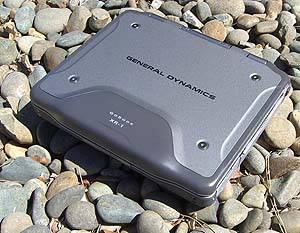 A few months ago I had the pleasure of touring Itronix's new facilities in Spokane, Washington. The official purpose of the trip was to get an idea of Itronix's path after having been acquired by General Dynamics in September of 2005. Now being part of the US$20 billion-plus conglomerate's C4 Systems, Itronix will be viewed quite differently, and that will also affect the product lines. One of the highlights of the trip was an early non-disclosure presentation by the company's director for the rugged notebook line, Anne Mettler, of a major new product, codenamed "Titan." The machine was going to be called the GoBook XR-1, the first product to be sold under the prestigious General Dynamics brand. A few months ago I had the pleasure of touring Itronix's new facilities in Spokane, Washington. The official purpose of the trip was to get an idea of Itronix's path after having been acquired by General Dynamics in September of 2005. Now being part of the US$20 billion-plus conglomerate's C4 Systems, Itronix will be viewed quite differently, and that will also affect the product lines. One of the highlights of the trip was an early non-disclosure presentation by the company's director for the rugged notebook line, Anne Mettler, of a major new product, codenamed "Titan." The machine was going to be called the GoBook XR-1, the first product to be sold under the prestigious General Dynamics brand.
So the XR-1 "Titan" is a new rugged notebook computer that will replace the aging GoBook III. That is a tall order as the GoBook line has a long and illustrious history that includes two Pen Computing Magazine Editor's Choice awards as the best high performance rugged notebook. We always appreciated Itronix's resolve to give its customers state-of-the art performance and technology now rather than letting them wait until a chip generation is already almost obsolete. Where the company had perhaps compromised a bit too much was in the somewhat pedestrian design of earlier GoBook models. Emphasis was clearly on performance and functionality, and less so on dazzling good looks. In the meantime, Itronix has realized that industrial workers, too, appreciate good-looking gear and worked with a major design firm on the new machine.
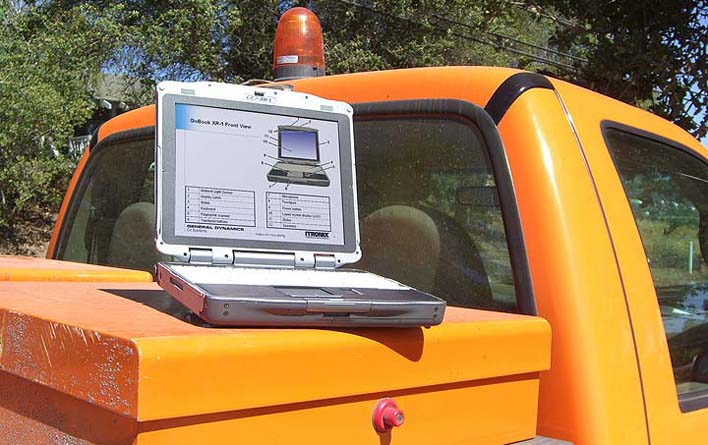
Setting the bar very high
The result is stunning. The GoBook XR-1 is a triumph of good industrial design. This is a rugged notebook computer that actually draws and pleases the eye as opposed to limiting itself to merely delivering reliable, workmanlike performance. But just as form follows function, function also must follow form, and Mettler made it clear that human design factors also stood very high on the list of project goals. And let's not forget performance. According to Mettler, the XR-1 is the most powerful computer in its class, using a 1.83GHz Intel Core Duo processor and the latest and greatest electronics, including a graphics subsystem powerful enough to support Vista (although the machine initially will not be Vista-logoed). Listening to Mettler speak, I felt that Itronix had set the bar quite high for itself, seeking to produce the successor to a very popular line of rugged notebooks, all the while excelling in performance, ergonomics, compact size and weight, wireless capabilities, and the ever more important security.
I learned additional facts. Environmental sealing is at the IP54 level. There are no external antennas (as the older GoBooks had) despite the unit's ability to accommodate no fewer than four radios. Users can turn off individual I/O devices. There is a programmable hardware "Turbo" button. Early testing suggested excellent benchmark performance, exceeding that of the competition. But perhaps the most amazing achievement is the significantly lower weight compared to the predecessor GoBook III. I was told how the Titan team was informed that they had to shave off almost two pounds compared to the older machine, down to 6.5 pounds. Initially no one thought it could be done, and yet they did it. The final design, actually, weighs 6.8 pounds, as it was decided to go for a more powerful 9-cell battery as opposed to the originally specified 6-cell powerpack.
Getting the review unit
Our review unit arrived a couple of months after that meeting, and reaffirmed the exceedingly positive impression I had had after the initial presentation. Despite its ruggedness and intended use in vertical market and governmental applications, the GoBook XR-1 is very stylish and elegant, especially the top part of it. Compared side by side with the XR-1, the older GoBook III looks dated and lacking in the clean lines and high-tech surface treatment that set the XR-1 apart. Panasonic's Toughbooks - the GoBooks' principal competitiors -- always had a design edge with their unique and consistent design. With the advent of the XR-1 that is no longer the case.
Stunning good looks
What makes the design of the XR-1 so unique, and the result so spectacular? Many things. There is a most appealing combination of colors and textures, all used to maximum advantage. Colors range from the familiar "Itronix-gray" plastic to silvers and darker grays. Textures range from smooth to a very attractive fine powder-coating. The design works exceptionally well as every material, color and texture used seems appropriate and just right. The XR-1 is smoother and has more curves than the boxy GoBook III, and the result is very pleasing to the eye. The top view is especially attractive. It just oozes competence and a strong sense of purpose. The overall result is, with all due respect to earlier Itronix machines, a whole different animal. It looks serious and very polished, and entirely deserving of the "General Dynamics" label on it.
A first pass around the XR-1
First impressions out of the way, I take a pass around the machine. For such a tough and rugged machine the ports seem to be protected only by slender plastic dust covers. I quickly notice that looks deceive; all ports are internally sealed. They look unprotected, but they are not. And since they have a "firewall" between them and the computer's innards, they are much easier to replace than ports that are part of the motherboard. Such connector assemblies are a bit larger than integrated components, but they are stronger as well. Itronix engineers had actually demonstrated that to me during my visit by suspending the entire computer from a standard RJ45 Ethernet cable. No problem at all.
Another advantage of this design approach is that ports can be where they should be instead of where there's room on the motherboard. As a result, the XR-1's interfaces are neatly and conveniently grouped together. On the right side (see picture below) are three USB 2.0 and a serial port on one side of the media bay that usually houses an internal optical drive, and an IEEE1394 FireWire on the other. On the left you find VGA, audio in/out, RJ45 Gigabit LAN, an RJ11 jack for the internal modem, power, and a PC Card Type II slot. You can order the machine with an optional Smart Card or Express54 card reader. The bottom includes a docking connector.

Versatile Media Bay
As mentioned, the XR-1 has a Media Bay that can accommodate either a second battery or a variety of optical drives, including DVD writers. Itronix chose a slot-load drive, thus reducing the chance of damaging or breaking the drive when the tray is out -- a decision we applaud.
Keyboard
Moving on to the keyboard, here Itronix -- in response to customer requests -- decided to stay close to the GoBook III solution: a full-size, 87-key sealed affair. The large white keys are very clearly marked and provide superb tactile feedback. Customers have their choice of a standard NiteVue glow-in-the-dark (an Itronix invention) or optional backlit keyboard. I really like the glow in the dark. There are choices for the touchpad as well. You can get either a resistive or a capacitive one, so you can even operate it with gloves on.
Handles
A versatile handle attach point mechanism can accommodate a variety of handles, including Itronix's "bathook" that is both a handle and a stand. The XR-1 redesigned "bathook" consists of nylon and soft rubber material, making it light, pleasant to the touch, and very strong. Itronix now also offers a front handle, perhaps because rival Panasonic has offered their CF-27/28/29 line with a very attractive front handle for many years.
Materials
In terms of materials, the XR1's chassis is made of magnesium. The stylish top is aluminum. Many parts are covered in plastic, but not just any plastic. This is TPU--Thermal Plastic Urethane, the stuff they use to make rollerblade wheels from. Itronix used this material for three reasons. It makes the unit feel cooler to the touch in places where it heats up. It is more conducive to RF performance. And it is nearly indestructible.
A look inside
We always open up our review units and the XR-1 was no exception. We didn't need to dismantle our tester all the way (after all, it was a valuable prototype that we most certainly did not want to return damaged!) to see that this machine is built like a tank. The molded magnesium chassis is both rock-solid and intricately designed. Looking at the layout and feeling the structural rigidity, you could never tell that the design team was under strict instructions to save and shave weight wherever they could. Despite the light weight of the XR-1, every part inside
seems solid and almost overbuilt rather than as thin as the designers could get away with. This, in our experience, separates machines that last from those that fail before their time.
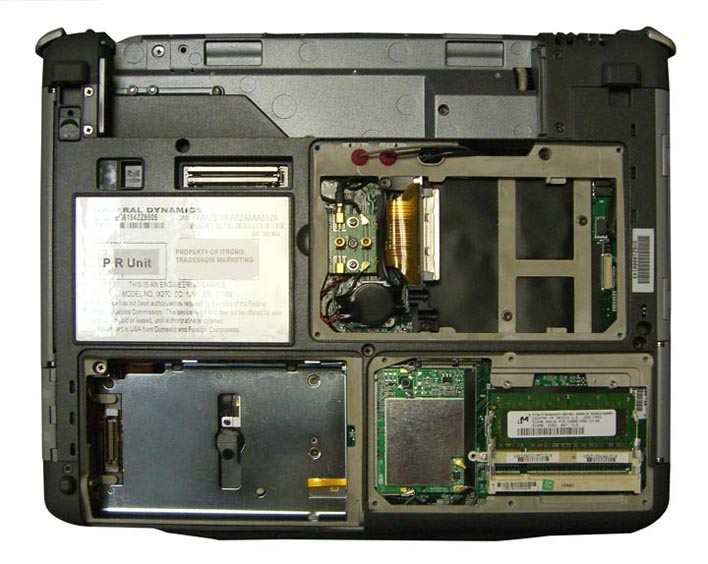
The underbelly
The picture of the bottomside of the XR-1 (see above) shows Itronix' approach. Each functional element has its place, each has its own compartment and its own seals. No need to expose the entire underside just to replace or add a component. The picture shows the battery removed. Though you can't tell by looking at it, the power pack is actually outside the computer. It is a structural part that easily, but very securely, snaps on. It can be removed very quickly, but in order to do so, you must depress two spring-loaded levers, going in different directions. The battery will never come off unintentionally. Each compartment cover is sealed. The hard disk and memory/wireless expansion compartments are plastic, or rather TPU - Thermal Plastic Urethane. The screws used to secure all the compartment covers are tiny, so they are not meant to be played with in the field. They are, however, all the same type and size - no need to figure out which goes where.
Hard drive enclosure and heater
The hard disk itself isn't just shock-mounted. It is shock-mounted in its own separate sub-assembly that snaps together and is secured with a screw. A black fabric strap helps you easily remove the assembly. Itronix thought of everything. The compartment cover has an O-ring seal. Once the cover is in place, you twist two fastener-latches to tighten the seal. Then you fold the latches down and secure them with screws. Engineering all the way. Since the XR-1 is designed for operating temperatures between minus ten and 140 degrees Fahrenheit, a hard drive heater is standard. Actually, the heater doesn't heat the whole drive; that would not make much sense, or could even be detrimental to the drive's longevity. Instead, it heats the area around the axis, to warm up the grease. The pictures below show the hard drive's protective case, open on the left so you can see the blue shock mounting subframe, and closed on the right. A very clean design.
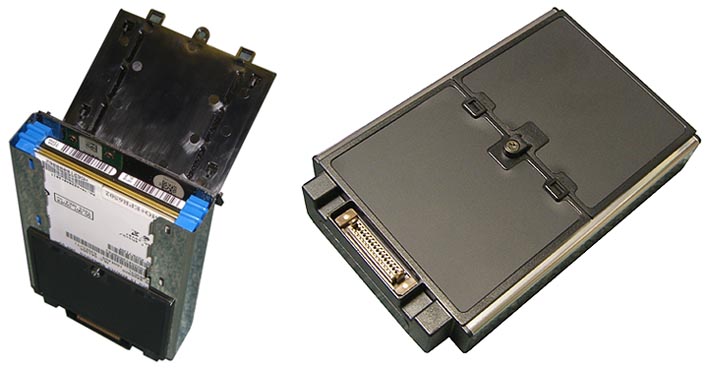
RAM and WLAN compartment
The RAM and WLAN compartment also has a plastic cover with a thick seal, protecting the WiFi assembly and the two RAM slots. Our tester came with one 512MB DDRII module. The compartment cover is secured with six screws.
CRMA and other wireless
The large CRMA Express (Common Radio Module Architecture) compartment, finally, has room for two radio assemblies and is protected by a sturdy, complex magnesium cover that seals off the CRMA compartment while allowing heat exchange in the outer sections and providing two external antenna plugs. And each compartment door is clearly labeled: RAM, WLAN, HDD, CRMA so that you don't have to guess should something have to be replaced. In its quest to reduce weight, Itronix left no leaf unturned. Those familiar with older CRMA modules will notice a difference: the new CRMA Express modules are much smaller and lighter than the older modules that were designed to accommodate bulky, full-size PC Cards. Wireless WAN options are EV-DO/1xRTT/CDMA or HSDPA/UMTS/GPRS/EDGE/GSM. Bluetooth is optionally available, as is a fully integrated GPS receiver with SiRFTrac high sensitivity software for superior signal acquisition speed and tracking.
I should also point out that Itronix always pays special attention to minimum interference and maximum radio performance. That is achieved via proper design, proper shielding, and proper antenna routing and management.
Thermal engineering
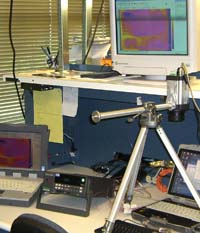 A deeper look inside the XR-1 reveals very substantial thermal engineering efforts which I had a chance to discuss with Itronix engineers in Spokane. The powerful T2400 Core Duo processor requires a fan, but that fan is so ingeniously designed and integrated that it does not reduce the IP54 rating. I didn't expect it would. I've seen Itronix fans work under water.
A deeper look inside the XR-1 reveals very substantial thermal engineering efforts which I had a chance to discuss with Itronix engineers in Spokane. The powerful T2400 Core Duo processor requires a fan, but that fan is so ingeniously designed and integrated that it does not reduce the IP54 rating. I didn't expect it would. I've seen Itronix fans work under water.
However, while the fan removes heat, it makes sense to design the overall system so that heat is dissipated optimally and so that there are no areas prone to overheating. Itronix engineers meticulously studied the heat load on test units by means of an infrared camera and via numerous sensors attached throughout the insides of the computers. That revealed heat flow and hot spots, allowing the engineers to reduce or eliminate them during the design process.
The picture to the left shows the infrared camera pointed at a GoBook XR-1 prototype running various applications and test programs specifically chosen to exercise different parts of the system. The monitor on top grapically shows the heat load data and how it changes over time. The result of this extensive thermal analysis is a remarkably cool-running final design.
Ruggedness
Despite its amazingly compact size and low weight, the GoBook XR-1 is a fully rugged computer. It was designed to meet and exceed MIL-STD 810F specs, and is sealed against water and dust intrusion to an IP54 ingress protection rating. IP54 means the computer is protected against dust and against water spray from all directions. The machine was also crash-tested for in-vehicle safety as many XR-1s will likely see duty in mobile environments. HazLoc certification and intrinsic safety are optionally available for units that will be deployed in specific environments, including Homeland Security applications. Some of these tests are quite elaborate. If, for example, a computer is being used in a bio-contaminated setting it will have to be scrubbed down with a mix of 90% water and 10% bleach, and be able to handle that. Other interesting special-duty features are a "stealth" boot mode where the unit starts up without blinking or making any sound, and the ability to selectively disable I/O devices.
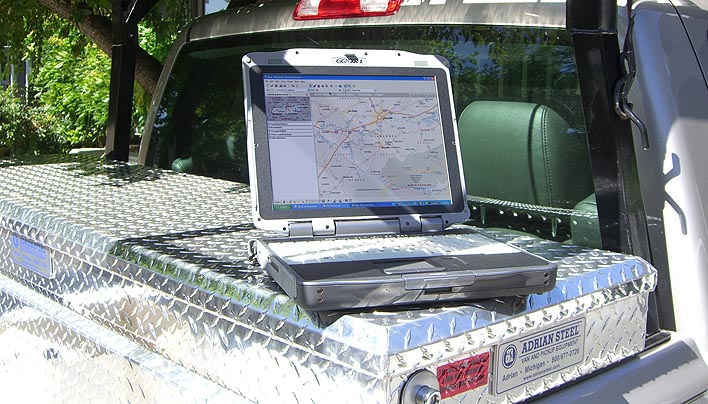
Display and touch screen
The 12.1" screen is transmissive. It is not a wide viewing angle design, something we've sort of come to expect in Tablet PCs. I asked Itronix whether they had considered the incomparable BOE Hydis display with its near 180 degree viewing angle in both directions. The answer, of course, is that the Hydis display is not as important in a standard notebook as it is in a Tablet PC slate that may be used either in landscape or in portrait orientation. Also, the "ColorVue" LCD Itronix chose is more than adequate. At 500 nit it is very bright and outdoor viewable. The XR-1 comes standard with a touch screen, but it is a different design than that used in the GoBook III where it was also standard. This time Itronix aimed for a highly responsive touchscreen as opposed to primarily aiming for palm-rejection. As a result, the new design feels more direct and responsive. Two slender plastic stily snap onto the side of the LCD case. They are fully integrated into the design. The unit's feet are integrated into the design as well, and they are designed so that they won't ever scratch anything.
Processor, subsystems, and battery life
There's no doubt that the XR-1 continues the Itronix tradition of offering superior performance. Even early 3DMark 2003 benchmarks showed the XR-1 to be 70% faster than the GoBook III and more than twice as fast as the Panasonic CF-29. Itronix clocked a final 3DMark 2003 benchmark of 1927. Our tester did even better, running a 1975.
The XR-1's 1.87MHz Intel Core Duo T2400 processor, 667MHz frontside bus, 2MB of L2 cache, and DDR2 RAM are all state -of-the-art, as is the ATI M22-CSP/32 external graphics controller. There's always a price to pay for performance, and the XR-1's Core Duo setup is a bit on the power-hungry side. Whereas the GoBook III's Intel 745 CPU, also not exactly an economy chip, consumed 24 watts, the XR-1's Core Duo needs 32 watts. To handle that power load, the XR-1 has a powerful 9-cell 80 watt-hour (7,200 mAH, 11.1 Volts) battery that's good for four to six hours. Add the smaller 41 watt-hour secondary battery and that increases to seven hours or more. You can't argue with that.
Security
Security is becoming an ever more important issue, and that includes both protection from various nasties that find their way into our computers as well as access control and data protection. The latter two are especially important in corporate and government applications where many XR-1s will be doing duty. It's therefore no surprise that Ironix paid special attention to security. That starts with common password protection, including pre-boot passwords, and goes on to "SuperPasswords" that can be used to selectively disable I/O devices. The XR-1 uses TPM v1.2 where a STMicroelectronics "Trusted Platform Module" security chip generates cryptographic keys that can be used in a variety of ways to preserve software and data integrity. Many corporate users rely on Smart Cards for access security and identification, and so an optional Smart Card reader is available. Fingerprint scanning and authentication is another technology that is increasingly integrated into notebook computers. A fingerprint scanner is also optionally available for the XR-1. On the software side, Wave Systems' Embassy Security Center handles all of the TPM functions, including password management and other authentication. For fingerprint biometrics the machine uses OmniPass software, by Softex Inc..
Software
The XR-1 comes with Windows XP Professional SP2. Software on our XR-1 included an excellent set of mobile computer tools: battery calibration, touch screen calibrator, hard disk backup and recovery, harddisk setup wizard, a media creation wizard, and various help systems. There is a TouchKit to configure the touch screen and various other Windows apps and utilities; and extensive XR-1 specific help.
Bottomline
As far as rugged notebook computers go, the General Dynamics GoBook XR-1 is as good as it gets. During my session with Itronix in Spokane, a company spokesperson indicated that this new machine will go head-to-head with Panasonic's Toughbook CF29 and its successors. "Only," the spokesperson had contended, "it is more durable, more powerful, and more ergonomic." We can't argue that point.
The GoBook XR-1 has clearly raised the bar for high performance rugged notebooks by a considerable margin. It has done so by offering a near perfect balance of performance, versatility, ruggedness and good industrial design. Yet, the XR-1 is smaller in every dimensions and lighter by almost two pounds than its direct predecessor, the GoBook III. That is a remarkable accomplishment. And one that is certain to give the competiton a very tough challenge to meet.
The XR-1 became available in September of 2006, and the retail price for the base configuration is US4,330.
– Conrad H. Blickenstorfer
| Type |
Rugged notebook
|
| Processor |
1.83GHz Intel Core Duo (T2400) |
| Graphics |
ATI Mobility X300 with total of 128MB
|
| OS |
Windows XP Professional SP2 |
| Memory |
512MB expandable to 2GB DDRII |
| Display |
12.1" XGA (1024 x 768) DynaVue TFT |
| Digitizer/Pens |
Touchscreen/2 |
| Keyboard |
87-key full-scale with glow-in-the-dark NiteVue |
| Storage |
80 to 120 GB 5400 RPM SATA hard disk with standard heater |
| Size |
11.8" x 9.65" x 1.98" |
| Ruggedness |
IP54, MIL-STD 810F, |
| Weight |
6.8 pounds incl. battery pack |
| Power |
80 WHr Lithium-Ion ("4 to 6 hours") |
| Communication |
Gigabit LAN, 56K Modem, internal Intel PRO/Wireless 3945ABG 802.11a/b/g wireless LAN radio, optional EV-DO/1xRTT/CDMA or HSDPA/UMTS/GPRS/EDGE/GSM, Bluetooth, GPS |
| Interface |
3 USB 2.0, audio/mic, IEEE1394, RJ-11, RJ-45, VGA, serial, dock, 2 PC Card Type II, CRMA Express modules for wireless |
| Price |
starting at US$4,330 |
| Contact |
General Dynamics Itronix |
|



